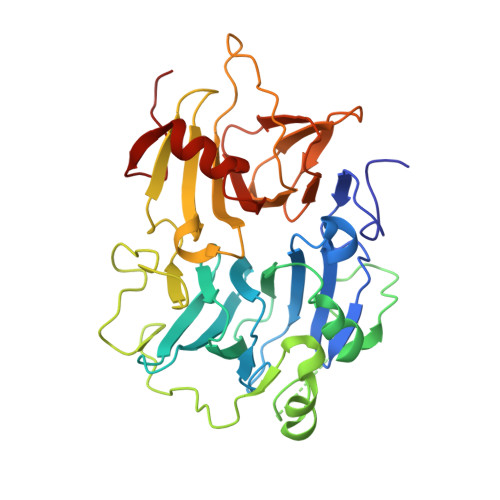Anaerobic Enzyme.Substrate Structures Provide Insight Into the Reaction Mechanism of the Copper- Dependent Quercetin 2,3-Dioxygenase.
Steiner, R.A., Kalk, K.H., Dijkstra, B.W.(2002) Proc Natl Acad Sci U S A 99: 16625
- PubMed: 12486225
- DOI: https://doi.org/10.1073/pnas.262506299
- Primary Citation of Related Structures:
1H1I, 1H1M - PubMed Abstract:
Quercetin 2,3-dioxygenase (2,3QD) is the only firmly established copper dioxygenase known so far. Depending solely on a mononuclear Cu center, it catalyzes the breakage of the O-heterocycle of flavonols, producing more easily degradable phenolic carboxylic acid ester derivatives. In the enzymatic process, two CC bonds are broken and concomitantly carbon monoxide is released. The x-ray structures of Aspergillus japonicus 2,3QD anaerobically complexed with the substrate kaempferol and the natural substrate quercetin have been determined at 1.90- and 1.75-A resolution, respectively. Flavonols coordinate to the copper ion as monodentate ligands through their 3OH group. They occupy a shallow and overall hydrophobic cavity proximal to the metal center. As a result of a van der Waals contact between the most outward flavonol A-ring and Pro(164), a flexible loop in front of the active site becomes partly ordered. Interestingly, flavonols bound to 2,3QD are bent at the C2 atom, which is pyramidalized. The increased local sp(3) character at this atom may stabilize a carbon-centered radical activated for dioxygen attack. Glu(73) coordinates the copper through its O epsilon 1 atom. The short distance of about 2.55 A between its O epsilon 2 atom and the flavonol O3 atom suggests that a hydrogen bond exists between the two atoms, indicating that Glu(73) can act as a base in flavonol deprotonation and that it retains the proton. Structure-based geometric considerations indicate O(2) binding to the flavonol C2 atom as the preferred route for flavonol dioxygenation.
Organizational Affiliation:
Laboratory of Biophysical Chemistry, Department of Chemistry, University of Groningen, Nijenborgh 4, 9747 AG, Groningen, The Netherlands.





















